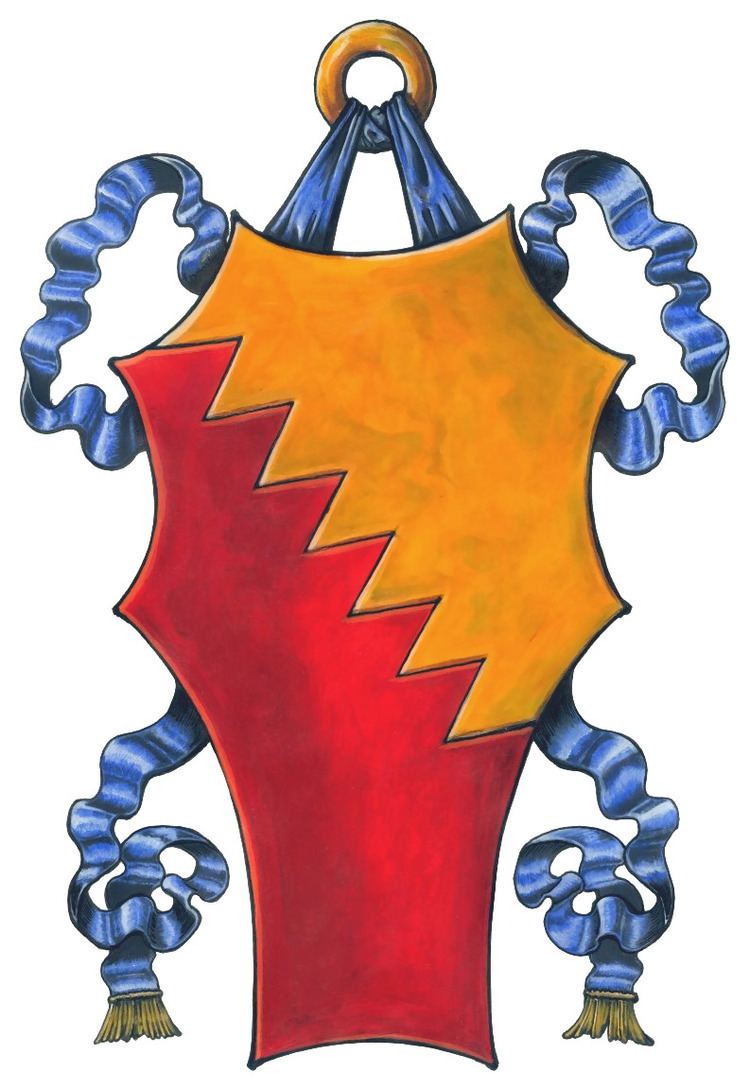Country Bologna Style(s) Lord | Titles "Lord of Bologna" Founded 1323 (1323) | |
 | ||
Estates Palazzo Bentivoglio (Bologna) Parent house Hohenstaufen
House of Sforza | ||
Bentivoglio (Latin: Bentivoius) was an Italian family that became the de facto rulers of Bologna and responsible for giving the city its political autonomy during the Renaissance.
Contents
History
The presence of the Bentivoglio family is first recorded in the city in 1323. Originally from the castle of that name in the neighborhood of Bologna, the family claimed descent from Enzio, King of Sardinia, an illegitimate son of Frederick II, Holy Roman Emperor.
During the fourteenth century, the family, belonging to one of the workingmen's guilds at Bologna, had gained power as pro-papist Guelph leaders in the fourteenth century.
Amid the faction-conflicts of the commune Giovanni I Bentivoglio, with the help of Gian Galeazzo Visconti, declared himself signore and Gonfaloniere di Giustizia on March 14, 1401. When the Visconti turned hostile, Giovanni was defeated and killed on June 26, 1402 at the Battle of Casalecchio and was interred in the church of San Giacomo Maggiore.
During the next few decades, the city's political status -and the family's fortunes- remained unpredictable. The son of Giovanni I, Anton Galeazzo (or Antongaleazzo, c. 1385-1435), was a lecturer in civil law who briefly assumed power in Bologna in 1420, but was quickly overthrown. He became a condottiero, and was assassinated by papal officials on December 23, 1435 due to fears over his growing power (he had returned to Bologna in December). During his reign the Bentivoglio received the fief of Castel Bolognese.
In 1438 Annibale I, a putative son of Anton Galeazzo (his mother, Lina Canigiani, was said to be uncertain of the boy's paternity and the matter was decided by dice)[1], led a city revolt against the Papacy. He tried to make peace with the Visconti of Milan and to convince the Pope not to place Bologna under his dominion. In 1442, the Visconti condottiere Niccolò Piccinino imprisoned Annibale and his supporters at Varano, but Annibale was freed by Galeazzo Marescotti in 1442. When Annibale returned to Bologna, the powers of government were confirmed upon him, a sign that the city recognized the family’s political importance. Annibale, however, was assassinated by his rival Battista Canneschi, with the support of Pope Eugene IV, on June 24, 1445.
He was succeeded by Sante I (1426-1463), also of dubious paternity and origin, but alleged to be a son of Ercole Bentivoglio, a cousin of Annibale I. Originally an apprentice of the wool guild of Florence, Sante ruled as signore of Bologna from 1442. Sponsored by Cosimo de' Medici, Sante Bentivoglio ushered in a brief period of political tranquility. Always technically under papal sovereignty, the city obtained some actual autonomy and recreates a regime of the feudal type, with a communal senate composed of the landowning nobility, the new rich, and the papal nobility. Bologna also strengthened its relations with Venice, Milan, and Florence.
Sante was succeeded by Giovanni II (1443-1508), the son of Annibale I, who ruled as virtual tyrant of Bologna. In 1506, the noble Bentivoglio family was brought to ruin by Pope Julius II when he expelled Giovanni II from Bologna.
A son of Giovanni II, Annibale II (1469-1540), married Lucrezia d'Este, an illegitimate daughter of Duke Ercole I of Ferrara, in 1487. He served as a condottiero. In rebellion against Julius II, he reentered Bologna in 1511 with the help of the French and ruled for only a year. He was hated by other rival families, such as the Ghislieri and the Canetoli, and was subsequently assassinated.
Annibale II was the last ruler of his line. In exile, the Bentivoglio family established themselves in Ferrara and produced several notable prelates.
Rulers of Bologna
The following members of the Bentivoglio family ruled over Bologna:
Other notable family members
Ercole Bentivoglio, the putative father of Sante I who lived in exile in Florence and Ferrara, wrote a long poem on dietetic, greatly extoling the medical properties of cheese. He also wrote satirical works.
The Bentivoglio Family, expelled from Bologna in 1506, established themselves in Ferrara, where they produced some important prelates, such as:
The third son of Giovanni II, Alessandro Bentivoglio, who had married Ippolita Sforza, became a counselor of the last duke of Milan and later governor of the town (1525), giving origin to a lombard branch of the family.
A notable recent member of the family is Galeazzo Benti, originally Galeazzo Bentivoglio, 20th century actor.
Power base
The Church of San Giacomo Maggiore, originally built in the mid-13th century, was adopted in the 15th century by the Bentivoglio family as the center of their power base in the surrounding neighborhood, and they embellished the church accordingly. It included the tomb of Anton Galeazzo Bentivoglio by Jacopo della Quercia and the Bentivoglio family's own private chapel, the altar of which has some striking artwork by Lorenzo Costa depicting family victories over other Bolognese dynasties.
